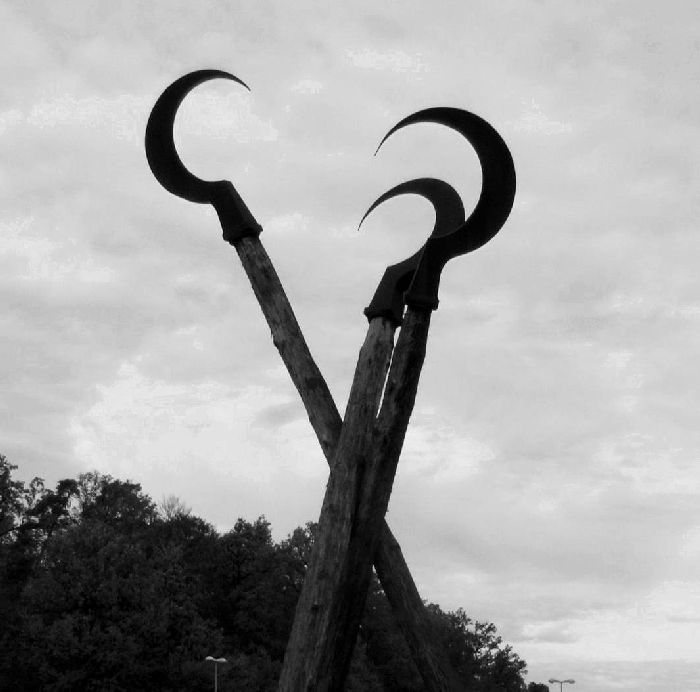Tuebingen City Center Memorials and Reminders
Pictures and text by Mark R. Hatlie
At the Holzmarkt in downtown Tuebingen, there are several reminders of the Second World War and the Holocaust. On the wall right underneath the large Stiftskirche, some plaques have been hanging for years, one since 1983, another since 1995, and a third, which was put up after the war, has recently been removed pending revision (see below). In addition, there is a temporary reminder of the Allied air raids on Germany painted on the downtown sidewalks.
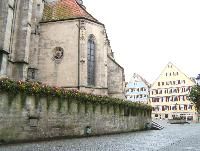
|
Here is a view of the Holzmarkt on a Sunday morning in October, one of those rare daytime moments when there is an open view of the whole square without pedestrians, information stands, vegitable sellers, etc. The two plaques and "missing plaque" empty space are clearly visible. Directly behind the photographer is the clothing store Haidt. During the 1920s, this was the number one address in Tübingen for textiles. In the mid 1930s, the owners were forced to sell and the ownership was "aryanized". Since 1938, it has been the Haidt store. There was a bit of a scandal in Tübingen when it celebrated its 50th anniversary in 1988. |

|
The two plaques still hanging, pictured below, have been recently restored. |
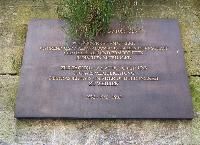
|
The plaque on the left, put up in 1983, reads: University City Tuebingen / In memory of our Jewish fellow citizens who were exiled and murdered during National Socialist rule / As a constant warning to us and an obligation to defend against racial hatred and intolerance. The perpetrators are not mentioned, but the word Mitbürger, euphamistically translated by me as "fellow citizens" is used. That term is now considered exclusionary. Note the different wording used in the other plaque. |

|
The plaque on the right, from 1995, starts in the passive voice, but goes on to explicitly and starkly name the perpetrators. Sinti and Roma are Gypsies: Sinti and Roma were murdered during the period of Nazi rule / They were subjected to forced sterilization and oppression / People from Tuebingen were among those who were murdered and oppressed. / Members of the university were among the originators of racist madness / People in our city were among the perpetrators. |
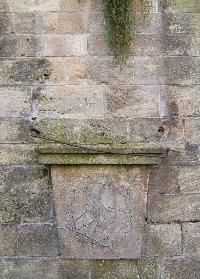
|
The third plaque listed the names of those men from Tuebingen who were kept as POWs in the Soviet Union. It listed their names and their date of return or death. Some of the names still had no date, indicating that the fate of the POW was still unknown. After a controversy, it was decided to remove the plaque and find another way to address the original intent of the memorial. The new memorial is still pending. |
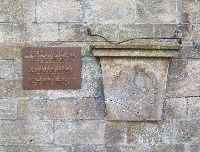
|
This picture and the following were taken in September, 2007. The new plaque was added some later. |
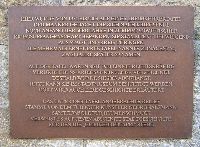
|
The plaque reads, "The men who were still prisoners of war, in most cases in the Soviet Union, in the early 1950s were remembered here on a "Returnee Plaque" from 1951 to 2003. Most of them came from the city and county of Tübingen. The plaque was renovated several times and showed 52 names at first and, starting in two years later, 59 names. / Since 1953 the list contained the names of some legally convicted Nazi war criminals. That is why it was removed in 2003. It can now be viewed in the city museum. The story of the plaque is told there. / The relief under the plaque is by the Tübingen artist Georg Salzmann. Including the ledge for flowers it serves the purpose for which the "Returnee plaque" stands." (Hier wurde von 1951 bis 2003 auf einer "Heimkehrertafel" der Männer gedacht, die sich nach Kriegsende noch Anfang der 50er Jahre in zumeist sowjetischer Kriegsgefangenschaft befanden. Sie stammten überwiegen aus der Stadt und Kreis Tübingen. Die mehrmals erneuerte Tafel nannte zunächst 52, zwei Jahre später 59 Namen. / Auf der Tafel waren seit 1953 einige rechtskräftig verurteilte NS-Kriegsverbrecher verzeichnet. Deshalb wurde sie 2003 abgehängt. Jetzt kann sie im Stadtmuseum besichtigt werden. Dort wird auch ihre Geschichte erläutert. / Das unter der Tafel angebrachte Relief stammt von dem Tübinger Künstler Georg Salzmann. Samt Konsole für Blumenschmuck verweist es auf jenen Abschnitt Stadtgeschichte für den die "Heinkehrtafel" steht.) |
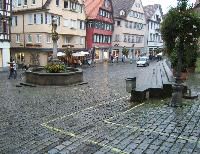
|
Just a few steps away from the plaques, near the entryway to the church, is a more recent memorial probably not intended to be permanent. These pictures were taken on September 30, 2005. They show the outlines of the underground tunnels built as air-raid shelters during the last two years of the war. The entryway was at the end shown near the pigeon by the fountain in this photo. You can read a bit about the tunnels in German at tuebingen.de. |
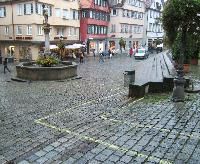
|
Today, the tunnels are closed off and filled, but this ghostly outline, ignoring the features of the street and buildings on the surface, is an effective memorial device. |
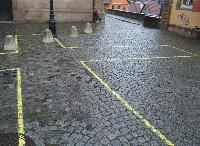
|
There is no explanation for the yellow lines nearby, so passers-by probably often have no idea that they are walking over a reminder of the war. Tuebingen suffered virtually no damage during the war, but the tunnels were used by residents of the city center. |
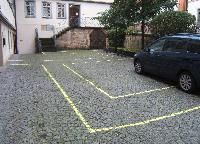
|
|
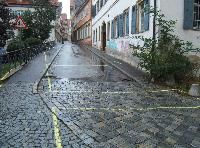
|
This is the view looking up Münzgasse. In the cellar on the building on the right there is another entrace into the shelter. That was the police building until well into the postwar period. During the Nazi period, it was also the Gestapo office in Tübingen. From here, the Tübingen Jews were gathered for deportation. |
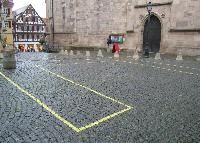
|
Thanks to Martin Ulmer from the Tübingen Geschichtswerkstatt for information on the Haidt store and on the police prefecture in Münzgasse.
